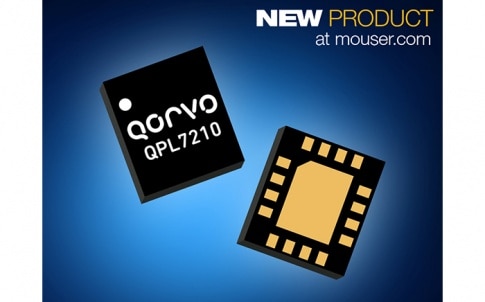
Mouser Electronics, Inc., the industry's leading New Product Introduction (NPI) distributor with the widest selection of semiconductors and electronic components, is now stocking the QPL7210 2.4 GHz Wi-Fi® LNA receive module from Qorvo. Designed for IEEE 802.11b/g/n/ac WLAN devices, Wi-Fi consumer equipment, routers or gateways, Qorvo’s fully integrated QPL7210 front-end module provides an exceptional wireless RF solution for connecting users to a variety of communications, networking, and Internet of Things (IoT) applications.
The Qorvo QPL7210 receive module, available from Mouser Electronics, offers best-in-class receiving immunity from interference and out-of-band blockers, while still achieving leading-edge receiving sensitivity across all Wi-Fi channels. The stand-alone module integrates a 2.4 GHz low-noise amplifier (LNA), an LNA bypass, and integrated filtering. The QPL7210 enables expanded capacity, throughput, and range, improving the coverage and user experience incorporating its highly selective bulk acoustic wave (BAW) filter functionality, used primarily for coexistence attenuation over module operating conditions. The module also includes integrated filters for second and third harmonics and 5 GHz rejection for dual-band, dual-concurrent operation.
The module offers receiving gain of 13.5 dB with a 2.5 dB noise figure. Optimized for 3.3 to 5V operation, at 3.3 V, the QPL7210 features a +30 dBm third-order intercept point (OIP3) and +3.5 dBm Input 1 dB Compression Point (IP1DB). Maximum bypass mode for receiving input power for the module is +24 dBm.
The 16-pin, 3.0 mm × 3.5 mm × 1 mm QPL7210 module meets or exceeds the RF front-end needs of IEEE 802.11b/g/n/ac/ax WLAN applications and is ideal for a broad array of RF wireless applications, including consumer Wi-Fi equipment, access points, wireless routers, residential gateways, and products focused on the IoT.
To learn more about the QPL7210, visit www.mouser.com/qorvo-qpl7210.










Radio wave weapon knocks out drone swarms
I hope they have assessed how easy it is to shield a drone against the attack. Hopefully the shielding would add too much weight.